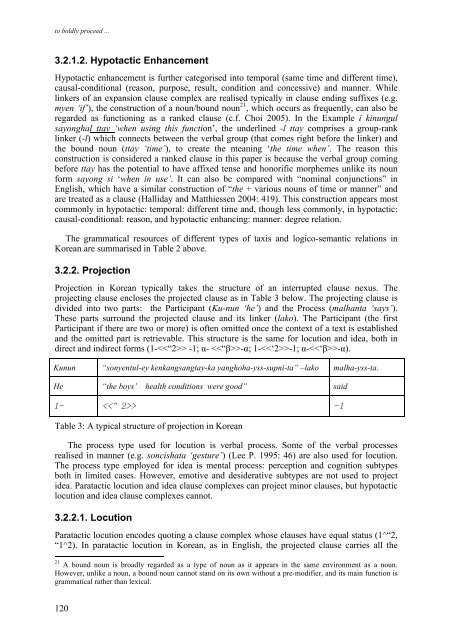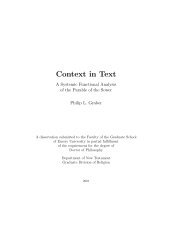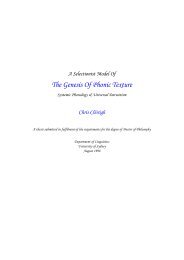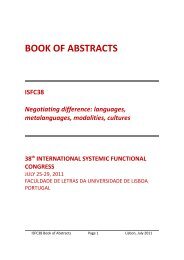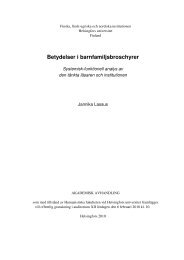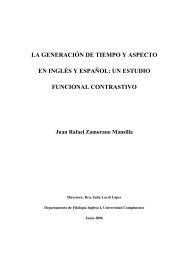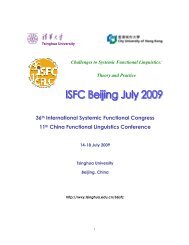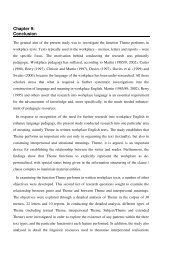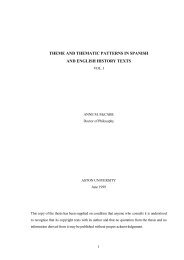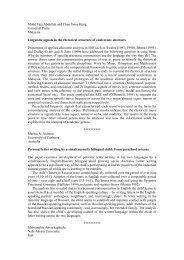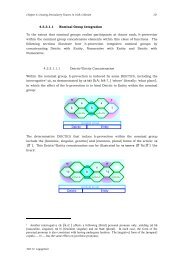the ISFC39 Proceedings - International Systemic-Functional ...
the ISFC39 Proceedings - International Systemic-Functional ...
the ISFC39 Proceedings - International Systemic-Functional ...
You also want an ePaper? Increase the reach of your titles
YUMPU automatically turns print PDFs into web optimized ePapers that Google loves.
to boldly proceed ...3.2.1.2. Hypotactic EnhancementHypotactic enhancement is fur<strong>the</strong>r categorised into temporal (same time and different time),causal-conditional (reason, purpose, result, condition and concessive) and manner. Whilelinkers of an expansion clause complex are realised typically in clause ending suffixes (e.g.myen ‘if’), <strong>the</strong> construction of a noun/bound noun 21 , which occurs as frequently, can also beregarded as functioning as a ranked clause (c.f. Choi 2005). In <strong>the</strong> Example i kinungulsayonghal ttay ‘when using this function’, <strong>the</strong> underlined -l ttay comprises a group-ranklinker (-l) which connects between <strong>the</strong> verbal group (that comes right before <strong>the</strong> linker) and<strong>the</strong> bound noun (ttay ‘time’), to create <strong>the</strong> meaning ‘<strong>the</strong> time when’. The reason thisconstruction is considered a ranked clause in this paper is because <strong>the</strong> verbal group comingbefore ttay has <strong>the</strong> potential to have affixed tense and honorific morphemes unlike its nounform sayong si ‘when in use’. It can also be compared with “nominal conjunctions” inEnglish, which have a similar construction of “<strong>the</strong> + various nouns of time or manner” andare treated as a clause (Halliday and Matthiessen 2004: 419). This construction appears mostcommonly in hypotactic: temporal: different time and, though less commonly, in hypotactic:causal-conditional: reason, and hypotactic enhancing: manner: degree relation.The grammatical resources of different types of taxis and logico-semantic relations inKorean are summarised in Table 2 above.3.2.2. ProjectionProjection in Korean typically takes <strong>the</strong> structure of an interrupted clause nexus. Theprojecting clause encloses <strong>the</strong> projected clause as in Table 3 below. The projecting clause isdivided into two parts: <strong>the</strong> Participant (Ku-nun ‘he’) and <strong>the</strong> Process (malhanta ‘says’).These parts surround <strong>the</strong> projected clause and its linker (lako). The Participant (<strong>the</strong> firstParticipant if <strong>the</strong>re are two or more) is often omitted once <strong>the</strong> context of a text is establishedand <strong>the</strong> omitted part is retrievable. This structure is <strong>the</strong> same for locution and idea, both indirect and indirect forms (1- -1; α- -α; 1--1; α--α).Kunun “sonyentul-ey kenkangsangtay-ka yanghoha-yss-supni-ta” –lako malha-yss-ta.He “<strong>the</strong> boys’ health conditions were good” said1- -1Table 3: A typical structure of projection in KoreanThe process type used for locution is verbal process. Some of <strong>the</strong> verbal processesrealised in manner (e.g. soncishata ‘gesture’) (Lee P. 1995: 46) are also used for locution.The process type employed for idea is mental process: perception and cognition subtypesboth in limited cases. However, emotive and desiderative subtypes are not used to projectidea. Paratactic locution and idea clause complexes can project minor clauses, but hypotacticlocution and idea clause complexes cannot.3.2.2.1. LocutionParatactic locution encodes quoting a clause complex whose clauses have equal status (1^“2,“1^2). In paratactic locution in Korean, as in English, <strong>the</strong> projected clause carries all <strong>the</strong>21 A bound noun is broadly regarded as a type of noun as it appears in <strong>the</strong> same environment as a noun.However, unlike a noun, a bound noun cannot stand on its own without a pre-modifier, and its main function isgrammatical ra<strong>the</strong>r than lexical.120


